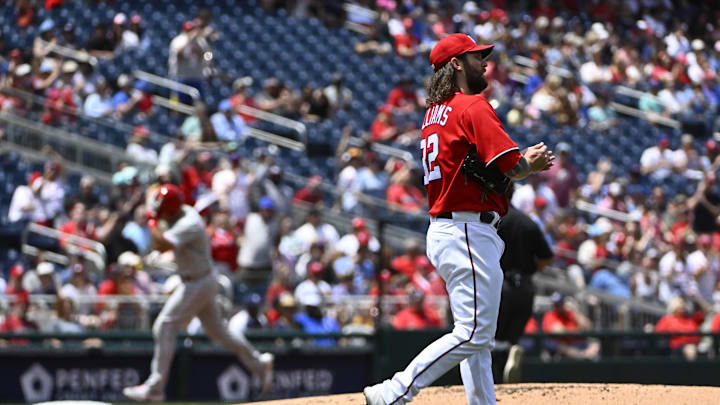It's no secret that the Nationals' starting pitchers have struggled with maintaining an effective fastball. Fans have seen both the up-and-coming rookies and the veteran starters have trouble navigating ABs and limiting hits when relying on their fastball for several seasons. The 2023 season was a particularly stark example of this, with most of the rotation having ineffective fastballs that could sometimes only be counted on to get them into a jam. Without this essential piece of their repertoire, Nats pitchers will likely continue to struggle unless they fine tune these pitches or workshop an alternative (more on that later).
The most glaring example of this last season was Trevor Williams. Williams' fastball failed him more often than not, and played a large role in his ERA of 5.55 in 2023. He threw this four-seamer 43.2% of the time, and was often met with unwelcome results. The staggeringly low velocity of 89.5 MPH and below average vertical and horizontal break on his fastball led to a pitch that opposing hitters feasted on. Batters posted an average of .283 on Williams fastball and slugged .563 against it. On top of how often they hit this pitch, batters also hit it relatively hard, with an average exit velocity of 90.5 MPH.
While some may chalk these stats up to a generally weak arsenal from Trevor Williams amidst a season that put him in many of the year-end categories pitchers want to avoid, the same cannot necessarily for young starter MacKenzie Gore. Gore's overall repertoire was not nearly as hittable as Williams' was, yet a somewhat similar fate befell Gore's fastball.
He leaned on his four-seamer more often than Trevor Williams, throwing it 59.5% of the time, but was met with results that still resembled those of his counterpart. Gore's fastball had a BAA of .279 and an xSLG of .518. Hitters also struck this pitch well, with a 89.5 average EV and a 46.6 Hard Hit %, culminating in 17 homers off his fastball alone. However, MacKenzie Gore has a much more tweakable four-seamer, with above average vertical movement and a 95 MPH velocity, as well as high-tier extension. Much of his 25.9 K% last season was owed to the 75 batters he put away with his fastball with.
So what is the Nationals' staff to do? The answer lies with Washington's young star Josiah Gray. Heading into the 2023 season, Gray was facing many of these same obstacles with his four seam fastball. Hitters were reading it too easily and squaring it up often. This led to Gray workshopping his pitch mix in the offseason of 2022, and incorporating a cutter into his arsenal. Last year, this work paid off, with Gray's cutter being an effective pitch, holding batters to a .243 average and putting up a run value of 7.
Josiah Gray, Nasty 88mph Cutter. ✂️ pic.twitter.com/e42ZDo0ptP
— Rob Friedman (@PitchingNinja) July 27, 2023
While the addition of another pitch worked for Gray, it may not work for some pitchers on the staff, so the solution may simply be to work on the already existing fastballs these pitchers utilize. Jake Irvin's in particular is a place to start, as his was reliable and effective in his appearances last year. As we head into Spring Training and come out of the offseason, the Nats' starters will likely have to utilize this time to hone the craft of their fastballs, and hopefully give themselves more room to work in 2024 without and overreliance on offspeed pitches. No matter what fix is presented, the Nationals rotation will need to attempt to cure their fastball woes if they are to be any more reliable this year.
